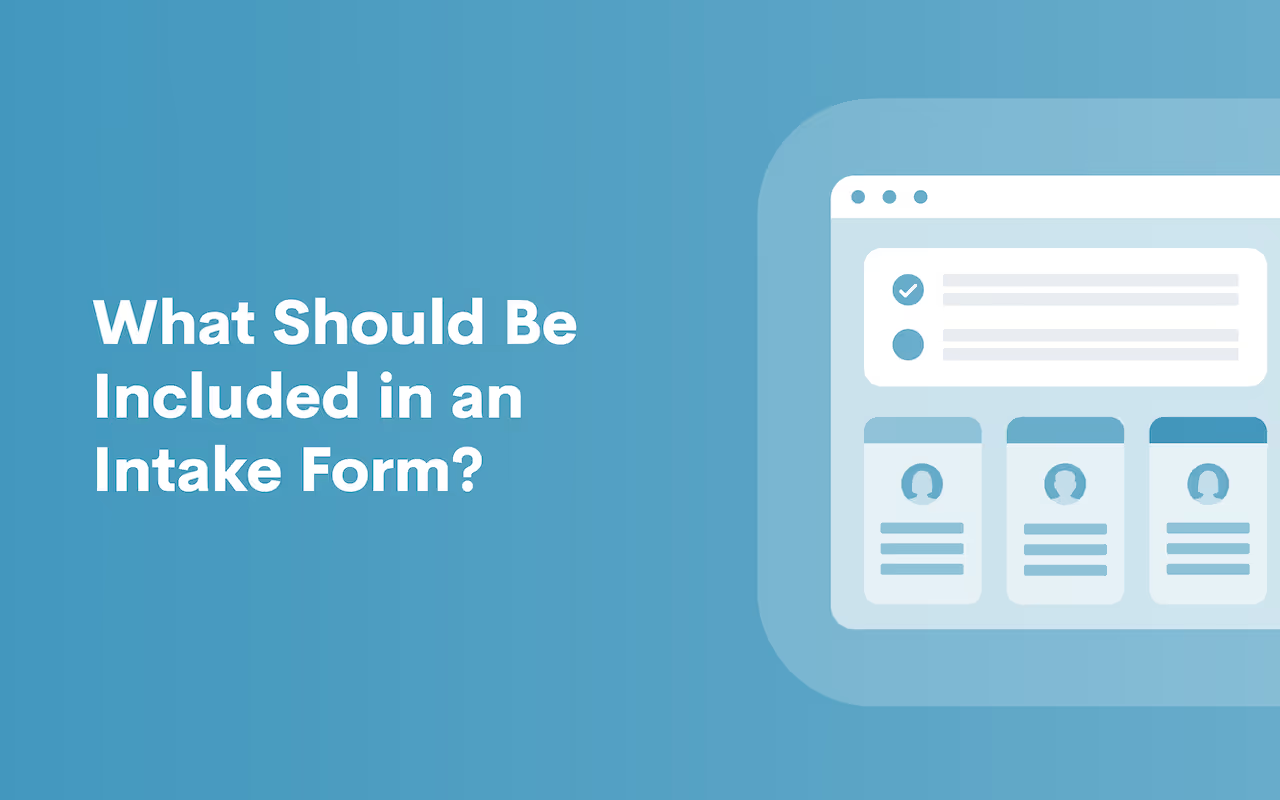What Should Be Included in an Intake Form?
Perfecting legal client intake forms is crucial, blending efficiency with detail to ensure law firms gather essential information upfront. Learn how to streamline your process, embracing templates and automation for a solid case foundation.

Table of contents
A legal client intake form is a crucial document used by law firms to gather essential information about a client and their legal matter. Legal client intake automation, including the use of an intake process template, streamlines the intake process so legal teams can prioritize casework. By establishing a clear and consistent process for client intake, you can save time, eliminate pesky errors and keep everyone in your practice on the same page.
What information does the client intake form collect?
A client intake form collects various information the legal team will need to handle a case, including:
- Client Information:
- Full name
- Date of birth
- Contact information (address, phone number, email)
- Occupation
- Legal issue details:
- Description of the legal issue or matter
- Date the issue arose
- Other relevant dates, events, or deadlines
- Names and contact information of other parties involved
- Case history:
- Any previous legal actions or proceedings related to the issue
- Current or previous legal representation for the matter
- Financial information:
- Billing information
- Fee structure (hourly rate, flat fee, contingency fee, etc.)
- Retainer agreement details
- Payment preferences
- Conflicts:
- Any potential conflicts of interest with the law firm or its attorneys
- Previous relationships with opposing parties or attorneys
- Documentation:
- Copies of relevant documents (contracts, agreements, court orders, etc.)
- Any correspondence related to the legal matter
- Goals:
- Client objectives and desired outcomes for the case
- Expectations regarding communication and updates from the attorney
- Confidentiality:
- Explanation of attorney-client privilege and confidentiality
- Consent for the law firm to use and share client information
- Authorization:
- Consent for the law firm to represent the client in the specified matter
- Signature of the client and date
Additionally, firms must ensure that their intake process complies with relevant legal and ethical requirements, including client confidentiality and data protection laws.
What should a client intake form include?
Intake form should be tailored to the specific practice areas and needs of the law firm. For example, in addition to the above information, an intake form for a personal injury attorney should include:
- Incident details:
- Date, time, and location of the accident or incident
- Description of how the accident occurred
- Parties involved (including witnesses, if any)
- Police report information (if applicable)
- Injuries:
- Description of injuries sustained in the accident
- Medical treatment received and healthcare providers involved
- Hospitalizations or surgeries
- Current medical condition and ongoing treatment needs
- Insurance:
- Details of the client's insurance coverage (health insurance, auto insurance, etc.)
- Information about the at-fault party's insurance (if known)
- Damages:
- Property damage incurred in the accident
- Lost wages or income due to inability to work
- Other financial losses incurred (e.g., medical bills, rehabilitation expenses)
- Witnesses:
- Names, contact details, and statements of any witnesses to the accident
- Visual evidence:
- Photographs or videos of the accident scene, vehicles involved, or injuries sustained
- Medical records:
- Authorization to obtain medical records and bills related to the injuries
- Copies of any medical reports or documentation already obtained by the client
Automated client intake form templates make it easy for firms to create their own intake process and efficiently capture the client information they need according to the practice area.
What is the purpose of an intake form?
A legal intake form gathers vital information about a prospective client and their legal issue that an attorney needs to assess the situation, evaluate the viability of the case, and determine whether they can provide assistance. When a prospective client completes the intake form, they formally engage with the attorney and give consent to seek legal advice and representation, which establishes the attorney-client relationship.
How do you write an intake form?
While intake forms were traditionally created manually and required a considerable amount of work, lawyers who handle their client intake process efficiently rely on legal intake software. A well-constructed intake form includes fields for a client’s basic information including name, address, contact details, and the details about the nature of their case. The more details that are requested on an intake form, the better a lawyer can qualify a lead before setting an appointment. Client intake software creates customized templates for lawyers that can be repurposed for each practice area in a firm and inputted directly into the law firm database, accelerating the process and reducing errors.
What is an intake form example?
Custom intake forms make it easy to qualify new prospects, organize contact information, and feed new matters into your automated processes. Here’s a client intake form example:
Is Your Firm Struggling with Client Intake? Lawmatics Has the Answer
Lawmatics offers best-in-class tools for legal client intake automation and much more. Are you ready to learn how to accelerate the growth of your firm by engaging and retaining new clients faster and more efficiently? Get a demo today.
Ready to grow your law firm with Lawmatics?
Schedule a demo of legal’s most trusted growth platform.








